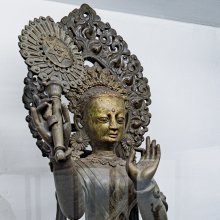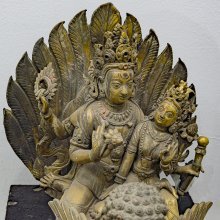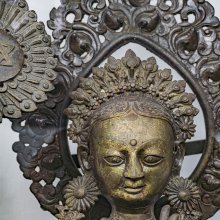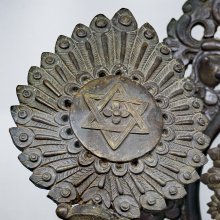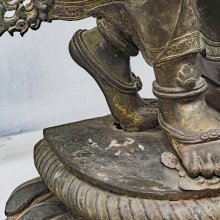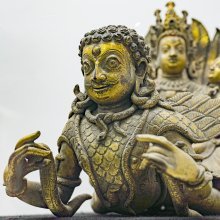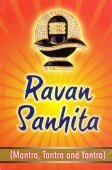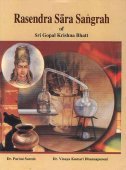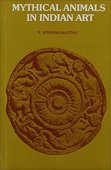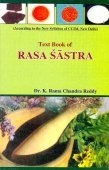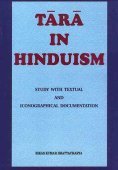Lakshmi, Lakṣmī: 52 definitions
Introduction:
Lakshmi means something in Buddhism, Pali, Hinduism, Sanskrit, Jainism, Prakrit, Marathi, Hindi, biology, Tamil. If you want to know the exact meaning, history, etymology or English translation of this term then check out the descriptions on this page. Add your comment or reference to a book if you want to contribute to this summary article.
The Sanskrit term Lakṣmī can be transliterated into English as Laksmi or Lakshmi, using the IAST transliteration scheme (?).
Images (photo gallery)
(+44 more images available)
In Hinduism
Natyashastra (theatrics and dramaturgy)
Source: Wisdom Library: Nāṭya-śāstra1) Lakṣmī (लक्ष्मी) is the Sanskrit name for a deity to be worshipped during raṅgapūjā, according to the Nāṭyaśāstra 3.1-8. Accordingly, the master of the dramatic art who has been initiated for the purpose shall consecrate the playhouse after he has made obeisance (e.g., to Lakṣmī).
2) Lakṣmī is also the Sanskrit name of one of the seven Nāṭyamātṛ (‘mothers of nāṭya’) mentioned in the Nāṭyaśāstra 3.86-87. They should be offered worship during ceremonies such as ‘consecration of the mattavāraṇī’ and ‘pouring ghee into sacrificial fire’.
Accordingly (85-87), “After saying these words for the happiness of the king, the wise man should utter the Benediction for the success of the dramatic production. [The Benediction]: Let mothers such as Sarasvati, Dhṛti, Medhā, Hrī, Śrī, Lakṣmī, and Smṛti protect you and give you success.”
Source: archive.org: The mirror of gesture (abhinaya-darpana)One of the Deva-vibhāvana (hands that indicate the forms which accord with the character and actions of Brahmā and other Devas).—Lakṣmī: two Kapittha hands held at the shoulders.
Note: ‘Held at the shoulders’ is to be understood in the case of all the Deva hands unless otherwise indicated.

Natyashastra (नाट्यशास्त्र, nāṭyaśāstra) refers to both the ancient Indian tradition (shastra) of performing arts, (natya—theatrics, drama, dance, music), as well as the name of a Sanskrit work dealing with these subjects. It also teaches the rules for composing Dramatic plays (nataka), construction and performance of Theater, and Poetic works (kavya).
Shaktism (Shakta philosophy)
Source: Wisdom Library: Śāktism1) Lakṣmī (लक्ष्मी, “Good Fortune, Prosperity”):—One of the female offspring from Mahālakṣmī (rajas-form of Mahādevī). Mahālakṣmī is one of the three primary forms of Devī, the other two being Mahākālī and Mahāsarasvatī. Not to be confused with Lakṣmī, she is a more powerful cosmic aspect (vyaṣṭi) of Devi and represents the guṇa (universal energy) named rajas. Also see the Devī Māhātmya, a Sanskrit work from the 5th century, incorporated into the Mārkaṇḍeya-Purāṇa.
2) Lakṣmī (लक्ष्मी, “fortune, success”):—Name of one of the sixty-four mātṛs to be worshipped during Āvaraṇapūjā (“Worship of the Circuit of Goddesses”, or “Durgā’s Retinue”), according to the Durgāpūjātattva. They should be worshipped with either the five upācāras or perfume and flowers.
Her mantra is as follows:
ॐ लक्ष्म्यै नमः
oṃ lakṣmyai namaḥ.
A similar mantra is mentioned by the same text, prefixed with ह्रीं (hrīṃ), to be worshipped at the goddess’s right.
Source: Wisdom Library: Śrīmad Devī BhāgavatamLakṣmī (लक्ष्मी, “wealth”):—One of the names attributed to Devī, as chanted by the Vedas in their hymns, who were at the time incarnated in their personified forms. See the Devī-bhāgavata-purāṇa chapter 5.51-68, called “the narrative of Hayagrīva”.
Source: Google Books: ManthanabhairavatantramLakṣmī (लक्ष्मी) refers to the Goddess (Śakti) (of the fourth of seven births before attaining liberation) according to the Janmasūtra.—The six beginning with the Buddhists and ending with the Śaivites are in the fettered state (paśubhāva). The seventh that has come into being is the House (veśman) of the Yoginī whose sign is liberation. In the first one Tārā is the goddess (śakti) and Ambikā in the second. Gāyatrī is (the form of the goddess) in the third (birth) and Lakṣmī in the fourth. In the fifth she is Rājñī and is said to be Umā in the sixth. In the seventh she is Khañjī who has descended in each Age.
Source: Brill: Śaivism and the Tantric Traditions (shaktism)Lakṣmī (लक्ष्मी) refers to the “good fortune (of liberation)”, according to Sāhib Kaul’s Śārikāstrotra.—Accordingly, “[...] When the marvelous sun of true devotion to you rises, the lotus of my heart is inflamed through true emotion. In it always resides, out of respect, the good fortune of liberation (mokṣa-lakṣmī) that is coveted by all. Having attained the strength of true intelligence through Jñānasvāmin, I know what there is to know and everywhere contemplate my own self. I, Sāhib Kaula, have composed this hymn to the lineage deity Śārikā, which contains the construction of her Mantra. [...]”.

Shakta (शाक्त, śākta) or Shaktism (śāktism) represents a tradition of Hinduism where the Goddess (Devi) is revered and worshipped. Shakta literature includes a range of scriptures, including various Agamas and Tantras, although its roots may be traced back to the Vedas.
Pancaratra (worship of Nārāyaṇa)
Source: Wisdom Library: Pāñcarātra1) Lakṣmī (लक्ष्मी, “observing”):—One of the twenty-four emanations of Lakṣmī accompanying Nārāyaṇa. This particular manifestation couples with his counterpart form called Vāsudeva and together they form the thirteenth celestial couple. Lakṣmī represents a form of the Goddess (Devī) as the wife of Viṣṇu, while Nārāyaṇa represents the personification of his creative energy, according to the Pāñcarātra literature.
2) Lakṣmī (लक्ष्मी) refers to an aspect of nṛsiṃha (‘man-lion’), according to the Vihagendra-saṃhitā 4.17, which mentions seventy-four forms (inlcuding twenty forms of vyūha). He is also known as Lakṣmīnṛsiṃha or Lakṣmīnarasiṃha. Nṛsiṃha is a Tantric deity and refers to the furious (ugra) incarnation of Viṣṇu.
The 15th-century Vihagendra-saṃhīta is a canonical text of the Pāñcarātra corpus and, in twenty-four chapters, deals primarely with meditation on mantras and sacrificial oblations.
Source: SriMatham: Vaiṣṇava Iconology based on Pañcarātra ĀgamaThe power (śakti) of Vishnu is represented as the power of multiplicity, or the Goddess of Fortune called Lakṣmī (“she-of-the-hundred-thousands”), she is also known as Śrī (“the-beautiful-one”). As the consort of Vishnu she appears with Him in every one of His incarnations. She is the Immaculate mediatrix of all Grace and is the embodiment of Compassion and Forgiveness on an absolute level.
Lakṣmī is depicted in three aspects and in each one her vehicle differs;
- In sattva-guna; she accompanies Mahā Viṣṇu upon Garuda.
- In rajo-guna; rides alone upon an elephant or sits upon a lotus.
- In tamo-guna; rides alone upon the owl Uluka.
Lakṣmī (लक्ष्मी) refers to the Goddess who personifies “wealth” and “fortune”, according to the Ahirbudhnyasaṃhitā, belonging to the Pāñcarātra tradition which deals with theology, rituals, iconography, narrative mythology and others.—Accordingly, “Lakṣmī does not dwell in the Brāhmaṇa alone, because of [his] excessive gentleness. Nor does She wish to remain in the Kṣatra alone (i.e. a member of the second social class to which also kings traditionally belong), being fearful of [his] excessive fierceness”.
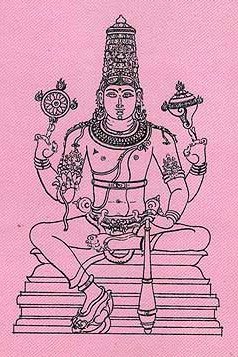
Pancaratra (पाञ्चरात्र, pāñcarātra) represents a tradition of Hinduism where Narayana is revered and worshipped. Closeley related to Vaishnavism, the Pancaratra literature includes various Agamas and tantras incorporating many Vaishnava philosophies.
Shilpashastra (iconography)
Source: Red Zambala: Hindu Icons and Symbols | DeviLakṣmī (लक्स्ह्मि, “She-of-the-hundred-thousands”).—The Śakti of the all-pervading Preserver, Vishnu, is represented as the power of multiplicity or goddess of fortune, Lakṣmī.When she is associated with the universal principle of beauty she is known as Śrī. Both "Lakshmi" and "Śrī" are mentioned in the Vedas in the context of "fortune." But Lakshmi as the Goddess of Fortune is depicted as a major goddess only in the epics.
As the consort of the Highest God Lord Vishnu, Lakṣmī is also the embodiment of compassion (anugraha-śakti) and tempers His quality of Justice (nigraha-śakti). As the Goddess of compassion she further transforms and sanctifies resources into their use for the benefit of others.
Source: Archaeological Survey of India: Śaiva monuments at Paṭṭadakal (śilpa)Lakṣmī (लक्ष्मी) is found as a sculpture at the temple of Lokeśvara, western wall, centre, west façade.—An image of the goddess Lakṣmī with two hands, a lotus in each one of her hands, is carved on the top of the central niche. She is shown seated on a lotus seat. That lotus seat is supported by two aquatic reptiles which look like makara, a mythical animal and two persons are jutting out of their opened jaws. Behind their snouts are seated two persons, one on each, with one hand lifted up as if they are lauding the Lady. In between the two makara is seated an animal with the face of a lion. This motif becomes very frequent and is carved in a number of places of Karnāṭaka or so called Vijayanagara Empire.
Semi-divine characters, such as Yakṣa and Gandharva couples, are also shown flying above, on either sides of the goddess (Lakṣmī). Their gestures make us believe that they must be eulogizing the virtues of the goddess of fortune.
Source: Shodhganga: The significance of the mūla-beras (śilpa)Lakṣmī is depicted as one of the two wifes of Śrīnīvāsa at the Kallazhagar Temple in Madurai, which represents a sacred place for the worship of Viṣṇu.—The wives of Śrīnīvāsa are Lakṣmī and Bhūmīdevī. They are found on the either side of him. Lakṣmī is represented with the right hand holding a flower in kaṭaka-hasta and with dolā in the left hand. Bhūmīdevī is represented holding kaṭaka in the left hand and dolā in the right. While representing in dance, all the depictions are the same, but the kapittha-hasta is held instead of the kaṭaka-hasta.
Lakṣmī is also depicted at the Andal Temple in Srivilliputtur (Villiputtur or Thiruvilliputtur), representing a sacred place for the worship of The Goddess (Devī).— Lakṣmī is found seated on the left thigh of Lakṣmī Nārāyaṇa with both the legs hanging loose. The left hand holds a lotus flower in kaṭaka-hasta and the right hand is in dolā-hasta. While depicting in dance, the left hand is in kapittha-hasta and the right hand in dolā-hasta.
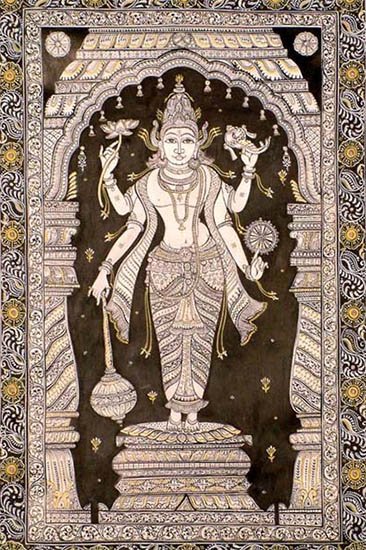
Shilpashastra (शिल्पशास्त्र, śilpaśāstra) represents the ancient Indian science (shastra) of creative arts (shilpa) such as sculpture, iconography and painting. Closely related to Vastushastra (architecture), they often share the same literature.
Vaishnavism (Vaishava dharma)
Source: ISKCON Press: GlossaryLakṣmī (लक्ष्मी).—The goddess of fortune and the eternal consort of the Supreme Lord as Lord Nārayaṇa, who resides in the unlimited spiritual realm of Vaikuṇtha.
Source: Shodhganga: The significance of the mūla-beras (vaishnavism)Lakṣmī (लक्ष्मी) is called as Kṣamā Devī, the goddess of earth; and Prajānām Bhavasī Mātā, the mother of all creatures. She is the beloved queen consort of Viṣṇu. She is called by various names like Ārana Valli (Vaḷḷi) Thāyār in Ulakalanṭān Perumāl Temple, Madurai Valli Thāyār in Kūṭal Alakar (Aḷakar) Temple, Vijayalakṣmī Thāyār in Vaṭabhadra Śayana Temple, and Solaimalai Nāciyār and Kalyāṇa Sundaravalli (Sundaravaḷḷi) Thāyār in Kallalakar Temple. The posture of Goddess Lakṣmī is full of grace and divinity. The goddess seems to be modeled in a submissive way to the Lord. Her basic natures shown are calmness, serenity and submissiveness. While showing Goddess Lakṣmī and lord Viṣṇu together in dance, the peaceful and erotic expressions can be improvised for Lakṣmī.
Goddess Lakṣmī is the embodiment of luck, wealth, prosperity and good fortune. It is believed that she blesses the devotees with abundance of wealth and riches. She also bestows fortunes and prosperity on them. She presides over the fertility and moisture of the soil and over the jewels and precious metals in the womb of the earth. She is specially prayed to by the farmers as she is the goddess of rice growing agriculture.

Vaishnava (वैष्णव, vaiṣṇava) or vaishnavism (vaiṣṇavism) represents a tradition of Hinduism worshipping Vishnu as the supreme Lord. Similar to the Shaktism and Shaivism traditions, Vaishnavism also developed as an individual movement, famous for its exposition of the dashavatara (‘ten avatars of Vishnu’).
Purana and Itihasa (epic history)
Source: archive.org: Puranic Encyclopedia1) Lakṣmī (लक्ष्मी).—Consort of Mahāviṣṇu. Origin. Devī originated from the left side of Paramātmā (Supreme Being). The beautiful Devī by a command from the Supreme Being divided herself into two enchanting damsels both equal in figure, splendour, age, majesty, adornment and love. One of these was Lakṣmīdevī and the other Rādhādevī. That born of the left was Ramā and that of the right, Rādhā. Rādhā wedded herself to the two-handed Śrī Kṛṣṇa and Lakṣmī also wanted the same person and so Bhagavān himself became two, Śri Kṛṣṇa from the left side as a two-handed person and as four-handed Viṣṇu from the right side. (9th Skandha. Devī Bhāgavata). (See full article at Story of Lakṣmī from the Puranic encyclopaedia by Vettam Mani)
2) Lakṣmī (लक्ष्मी).—A daughter of Dakṣaprajāpati. She was married to Dharmadeva. (Śloka 14, Chapter 66, Ādi Parva).
Source: archive.org: Nilamata Purana: a cultural and literary studyLakṣmī (लक्ष्मी) according to the Nīlamatapurāṇa.—The Nīlamata is aware of her birth from the sea. Called by the names Śrī, Lakṣmī and Karīṣiṇī, she is capable of purifying three worlds and, at Kaśyapa’s request, takes the form of a river Viśokā to purify the people of Kaśmīra. Her worship is prescribed in many festivals like Sukhasuptikā, Rāma’s birth-day festival and Irāmañjarīpūjana. Śrī Pañcamī—fifth day of the bright half of Caitra—is wholly dedicated to her worship. The purifying abode of auspiciousness, she is the Supreme Power assuming forms of different goddesses. She is also identified with Umā and Kaśmīrā.
Source: archive.org: Shiva Purana - English Translation1) Lakṣmī (लक्ष्मी, “fortune”) is one of the twenty-four daughters of Dakṣa by Prasūti: one of the three daughters of Svāyambhuvamanu and Śatarūpā, according to the Śivapurāṇa 2.1.16:—“Dakṣa begot twenty-four daughters. Thirteen daughters Śraddhā etc. were given to Dharma in marriage by Dakṣa. O lordly sage, listen to the names of Dharma’s wives. Their names are [... Lakṣmī (fortune),...]. Thereupon the entire universe consisting of three worlds, mobile and immobile was filled (with progeny). Thus according to their own actions and at the bidding of Śiva innumerable famous Brahmins were born out of the various living beings”.
2) Lakṣmī (लक्ष्मी) is used to describe Goddess Umā, according to the Śivapurāṇa 2.3.3.—Accordingly, as the Gods eulogized Umā (Durgā/Satī) with devotion:—“[...] you are sleep in all living beings; you are hunger, satiety, thirst, splendour, brilliance and contentment. You are the delighter of every one for ever. To those who perform meritorious actions you are the goddess of fortune (i.e., lakṣmī—tvaṃ lakṣmīḥ puṇyakartṝṇāṃ). To the sinners you are the eldest sister, the deity of Ignominy; you are peace for the universe, and the mother sustaining lives”.
3) Lakṣmī (लक्ष्मी) refers to one of the sixteen celestial ladies (Divyanārī), according to the Śivapurāṇa 2.3.50 (“Description of fun and frolic”).—Accordingly, as Brahmā narrated to Nārada: “[...] Then the sixteen celestial ladies arrived there and saw the couple [i.e., Śiva and Pārvatī] with great respect. They were Sarasvatī, Lakṣmī, Sāvitrī, Jāhnavī, Aditi, Śacī, Lopāmudrā, Arundhatī, Ahalyā, Tulasī, Svāhā, Rohiṇī, Vasundharā, Śatarūpā, Saṃjñā and Rati. There were several virgins of the gods, Nāgas, and the sages. They were charming and attractive. Who can enumerate them? [...]”.
Source: Cologne Digital Sanskrit Dictionaries: The Purana Index1a) Lakṣmī (लक्ष्मी).—Also Ramā and Śrī—born out of the churning of the ocean; seeing her unequalled beauty, the sages anointed her amidst divine music and dancing. Every god presented her with something or other. She desired to be a partner of Hari, and the latter assigned her a place in his chest. Presented Prthu with inexhaustible wealth;1 a kalā of Brahmā; a devī attending on Soma; a Varṇa śakti;2 a mind-born daughter of Brahmā;3 consort of Viṣṇu;4 brought forth Kāma by Dharma;5 left Nārāyaṇa and loved Soma along with eight other devīs;6 wealth;7 residing in the lotus in śrī sara;8 with the appellation of Sitā in Gayā.9
- 1) Bhāgavata-purāṇa VIII. 8. 8-29; IV. 15. 16.
- 2) Brahmāṇḍa-purāṇa III. 65. 26; IV. 19. 74; 35. 94; 44. 62.
- 3) Matsya-purāṇa 171. 32.
- 4) Ib. 187. 45.
- 5) Ib. 171. 42.
- 6) Ib. 23. 24.
- 7) Ib. 221. 12; 246. 62; 247. 30; 285. 20.
- 8) Vāyu-purāṇa 37. 8.
- 9) Ib. 106. 58; 112. 64.
1b) A daughter of Dakṣa1 and a wife of Dharma, and mother of Sūnṛtā;2 a mother goddess as mūlaprakṛti or māyā;3 abode of, in the Meru.4
- 1) Vāyu-purāṇa 10. 25, 34; 55. 43; Brahmāṇḍa-purāṇa II. 9. 49, 58; 26. 45.
- 2) Brahmāṇḍa-purāṇa II. 36. 88; Vāyu-purāṇa 62. 76; Viṣṇu-purāṇa I. 7. 23, 28; 8-21.
- 3) Brahmāṇḍa-purāṇa IV. 7. 72.
- 4) Viṣṇu-purāṇa II. 2. 47.
1c) A daughter of Bhṛgu and Khyātī and sister of Dhātā and Vidhātā;1 gave Baladeva an ear-ring and a lotus garland at Vṛndāvana.2
Source: JatLand: List of Mahabharata people and placesLakṣmī (लक्ष्मी) refers to the name of a Lady mentioned in the Mahābhārata (cf. I.60.13). Note: The Mahābhārata (mentioning Lakṣmī) is a Sanskrit epic poem consisting of 100,000 ślokas (metrical verses) and is over 2000 years old.
Source: Shodhganga: The saurapurana - a critical studyLakṣmī (लक्ष्मी) refers to one of the three daughters of Bhṛgu and Khyāti: one of the twenty-four daughters of Dakṣa and Prasūti, according to the Vaṃśa (‘genealogical description’) of the 10th century Saurapurāṇa: one of the various Upapurāṇas depicting Śaivism.—Accordingly, Dakṣa produced in Prasūti twenty-four daughters. [...] [Khyāti was given to Bhṛgu.]. [...] From Bhṛgu through Khyāti, Lakṣmī (the beloved of Nārāyaṇa), Dhātā and Vidhātā were born. Dhātā and Vidhātā became the Sons-in-law of Meru marrying Āyati and Niyati respectively.

The Purana (पुराण, purāṇas) refers to Sanskrit literature preserving ancient India’s vast cultural history, including historical legends, religious ceremonies, various arts and sciences. The eighteen mahapuranas total over 400,000 shlokas (metrical couplets) and date to at least several centuries BCE.
Kavya (poetry)
Source: Shodhganga: A critical appreciation of soddhalas udayasundarikathaLakṣmī (लक्ष्मी) or Śrī to whom several references are made in the text, is the consort of Viṣṇu and is represented in sculptors as shampooing the feet of her lord reclining on the Śeṣa. A complete picture of this pose has been given by Kālidāsa, where she is said to sit on a lotus, her silken robe covering her girdle and Viṣṇu’s feet-lying on her lap.

Kavya (काव्य, kavya) refers to Sanskrit poetry, a popular ancient Indian tradition of literature. There have been many Sanskrit poets over the ages, hailing from ancient India and beyond. This topic includes mahakavya, or ‘epic poetry’ and natya, or ‘dramatic poetry’.
Shaivism (Shaiva philosophy)
Source: academia.edu: Yakṣiṇī-sādhana in the Kakṣapuṭa tantraLakṣmī (लक्ष्मी) is the name of one of the thirty-six Yakṣiṇīs mentioned in the Uḍḍāmareśvaratantra. In the yakṣiṇī-sādhana, the Yakṣiṇī is regarded as the guardian spirit who provides worldly benefits to the practitioner. The Yakṣiṇī (e.g., Lakṣmī) provides, inter alia, daily food, clothing and money, tells the future, and bestows a long life, but she seldom becomes a partner in sexual practices.
Source: SOAS University of London: Protective Rites in the Netra TantraLakṣmī (लक्ष्मी) refers to one of the Devīs associated with Nārāyaṇa, according to the Netratantra of Kṣemarāja: a Śaiva text from the 9th century in which Śiva (Bhairava) teaches Pārvatī topics such as metaphysics, cosmology, and soteriology.—Accordingly, [verse 13.1-9, while describing the appearance and worship of Viṣṇu, in the form of Nārāyaṇa]—“[...] [The Mantrin] places devīs at the four cardinal directions and members at the intermediate compass-points. Thus, he worships [the Devīs] Jayā, Lakṣmī, Kīrti, and Māyā at the cardinal directions, [where they] hold a noose and hook, hands [in the mudrās of] granting wishes and protection. He meditates [on them] before the eyes of the Deva, assuming the shape of [whichever] goddess is chosen. The members are similar to the Deva, [with] his color and hold [his same] weapons”.

Shaiva (शैव, śaiva) or Shaivism (śaivism) represents a tradition of Hinduism worshiping Shiva as the supreme being. Closely related to Shaktism, Shaiva literature includes a range of scriptures, including Tantras, while the root of this tradition may be traced back to the ancient Vedas.
Chandas (prosody, study of Sanskrit metres)
Source: Journal of the University of Bombay Volume V: Apabhramsa metres (2)Lakṣmī (लक्ष्मी) is the name of a catuṣpadi metre (as popularly employed by the Apabhraṃśa bards), as discussed in books such as the Chandonuśāsana, Kavidarpaṇa, Vṛttajātisamuccaya and Svayambhūchandas.—Lakṣmī has 24 mātrās in each of its four lines, divided into the groups of 4, 5, 5, 5 and [ISS] mātrās.
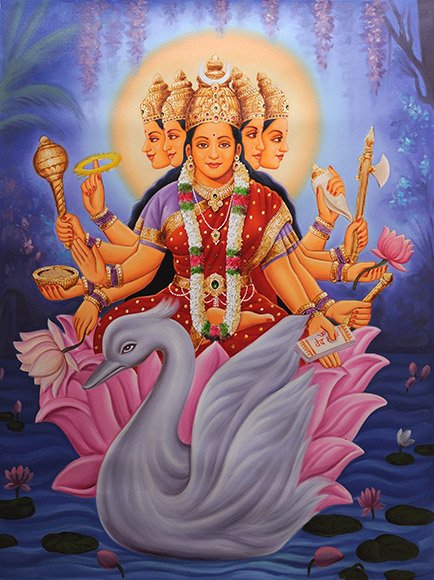
Chandas (छन्दस्) refers to Sanskrit prosody and represents one of the six Vedangas (auxiliary disciplines belonging to the study of the Vedas). The science of prosody (chandas-shastra) focusses on the study of the poetic meters such as the commonly known twenty-six metres mentioned by Pingalas.
Ayurveda (science of life)
Nighantu (Synonyms and Characteristics of Drugs and technical terms)
Source: WorldCat: Rāj nighaṇṭuLakṣmī (लक्ष्मी) is another name for Vṛddhi, an unidentified medicinal plant, according to verse 5.28-33 of the 13th-century Raj Nighantu or Rājanighaṇṭu. The fifth chapter (parpaṭādi-varga) of this book enumerates sixty varieties of smaller plants (kṣudra-kṣupa). Together with the names Lakṣmī and Vṛddhi, there are a total of twelve Sanskrit synonyms identified for this plant.

Āyurveda (आयुर्वेद, ayurveda) is a branch of Indian science dealing with medicine, herbalism, taxology, anatomy, surgery, alchemy and related topics. Traditional practice of Āyurveda in ancient India dates back to at least the first millenium BC. Literature is commonly written in Sanskrit using various poetic metres.
Jyotisha (astronomy and astrology)
Source: Wisdom Library: Brihat Samhita by VarahamihiraV (व्) refers to “prosperity”, according to the Bṛhatsaṃhitā (chapter 4), an encyclopedic Sanskrit work written by Varāhamihira mainly focusing on the science of ancient Indian astronomy astronomy (Jyotiṣa).—Accordingly, “Having thus described the shape of the moon we next proceed to describe her size (generally): [...] If she should appear broad, she will increase the prosperity of the princes [i.e., narapati-lakṣmī-vivṛddi]; if she should appear big there, will be happiness in the land, and if small, there will be abundance of that grain which men like most”.
Source: Google Books: Studies in the History of the Exact Sciences (Astronomy)Lakṣmī (लक्ष्मी) refers to “prosperity”, according to the Ghaṭikāyantraghaṭanāvidhi, an unpublished manuscript describing the ritual connected with the setting up of the water clock and its invocation.—Accordingly, “[Now the pala-verses]: [...] May the Sun [i.e., mārtāṇḍa], the Moon [i.e., tārānātha], Mars [i.e., kṣoṇīsūnu], Mercury [i.e., indusūnu], Jupiter [i.e., vāgīśa], Venus [i.e., daityācārya], Saturn [i.e., chāyāputra], Rāhu and Ketu, all these, together with the lunar mansions beginning with Aśvinī, and all these stars, produce auspiciousness, constant good health, prosperity [i.e., lakṣmī], and longevity [for the couple]”.

Jyotisha (ज्योतिष, jyotiṣa or jyotish) refers to ‘astronomy’ or “Vedic astrology” and represents the fifth of the six Vedangas (additional sciences to be studied along with the Vedas). Jyotisha concerns itself with the study and prediction of the movements of celestial bodies, in order to calculate the auspicious time for rituals and ceremonies.
General definition (in Hinduism)
Source: WikiPedia: HinduismLakshmī (लक्ष्मी): Goddess of prosperity, wealth and good fortune. She is the consort of Vishnu and an aspect of Devi.
Source: Shodhganga: The significance of the mūla-berasLakṣmī (लक्ष्मी) is the wife of Viṣṇu who was born out of the sea of milk. She is also called Śrīdevī and is considered to be the goddess of the sky and of fortune. When Viṣṇu incarnated himself in Rāma, Lakṣmī was incarnated in Sītā and when Viṣṇu was incarnated in Kṛṣṇa, Lakṣmī was incarnated in Rukminī.
In Buddhism
Tibetan Buddhism (Vajrayana or tantric Buddhism)
Source: Wisdom Library: Tibetan BuddhismLakṣmī (लक्ष्मी) is the name of Vidyārājñī (i.e., “wisdom queen”) mentioned as attending the teachings in the 6th century Mañjuśrīmūlakalpa: one of the largest Kriyā Tantras devoted to Mañjuśrī (the Bodhisattva of wisdom) representing an encyclopedia of knowledge primarily concerned with ritualistic elements in Buddhism. The teachings in this text originate from Mañjuśrī and were taught to and by Buddha Śākyamuni in the presence of a large audience (including Lakṣmī).

Tibetan Buddhism includes schools such as Nyingma, Kadampa, Kagyu and Gelug. Their primary canon of literature is divided in two broad categories: The Kangyur, which consists of Buddha’s words, and the Tengyur, which includes commentaries from various sources. Esotericism and tantra techniques (vajrayāna) are collected indepently.
In Jainism
General definition (in Jainism)
Source: Wisdom Library: Jainism1) Lakṣmī (लक्ष्मी) is the mother of Candraprabha according to Digambara (but she is named Lakṣmaṇā according to Śvetāmbara), according to the Ācāradinakara (14th century work on Jain conduct written by Vardhamāna Sūri). Candraprabha is the eighth of twenty-four Tīrthaṅkaras in Janism. A Tīrthaṅkara is an enlightened being who has conquered saṃsāra (cycle of birth and death), leaving behind him a path for others to follow.
The husband of Lakṣmī is Mahasena. It is an ancient Jain practice to worship the Tīrthaṅkara’s parents in various rites, such as the pratiṣṭhāvidhi.
2) Lakṣmī (लक्ष्मी).—The name of a Goddess residing over the padmahrada (big lotus-island) which lies in the center of a lake named Puṇḍarīka. This lake is situated on top of the mountain range (varṣadharaparvatas) named Śikharin, one of the six mountain ranges in Jambūdvīpa. Jambūdvīpa lies at the centre of madhyaloka (‘middle world’) and is the most important of all continents and it is here where human beings reside.
Source: archive.org: The Jaina Iconography1) Lakṣmī (लक्ष्मी) or Śrī is the name of a deity commonly depicted in Jaina art and iconography.—Śrī or goddess of wealth has been described in a Digambara manuscripts as a four-handed figure holding a flower and lotus. The same goddess in a Śvetāmbara manuscripts is represented as riding on an elephant and holding, as symbol, lotuses. he worship of Lakṣmī has a great hold upon the orthodox Jainas of both communities. The special day on which honour is done to the goddess of wealth is called Dhanaterasa. On the same occasion, the Śvetāmbara women polish their jewellery and ornaments in honour of Lakṣmī.
The description of Jaina Lakṣmī (Śrī), given above, does not far differ from that of the Brahmanic Śrī or Kamalā. Only in one point, it appears, namely in the riding on an elephant, the Jaina image presents an originality. It must be noted here that the conception of Lakṣmī even in Jainism is very old as the goddess is mentioned in the Kalpasūtra as one of the objects of Triśalā’s dream.
2) Lakṣmī (लक्ष्मी) is the name of a Yoginī mentioned in various Jaina manuscripts, often being part of a list of sixty-four such deities. How the cult of the Tantrik Yoginīs originated among the vegetarian Jainas is unknown. The Yoginīs (viz., Lakṣmī) are known as attendants on Śiva or Pārvatī. But in the case of Jainism, we may suppose, as seen before that they are subordinates to Kṣetrapāla, the chief of the Bhairavas.
Source: archive.org: TrisastisalakapurusacaritraLakṣmī (लक्ष्मी) is the wife of Sunāsīra and mother of Subuddhi, according to chapter 1.1 [ādīśvara-caritra] of Hemacandra’s 11th century Triṣaṣṭiśalākāpuruṣacaritra: an ancient Sanskrit epic poem narrating the history and legends of sixty-three illustrious persons in Jainism.
Accordingly,
Source: Encyclopedia of Jainism: Tattvartha Sutra 3: The Lower and middle worlds“After he had enjoyed pleasures unceasingly, the soul of Vajrajaṅgha [i.e., previous incarnation of Ṛṣabha] fell from the exhaustion of his life-span, just as a snow-ball melts in the sun. In Jambūdvīpa, in the Videhas, in the city Kṣitipratiṣṭhita, he was born as the son, named Jīvānanda, of the physician Suvidhi. [...] At the same time in this city four other boys were born, like pieces of dharma joined to bodies. [...] Another was the son of the minister Sunāsīra and his wife Lakṣmī, named Subuddhi, resembling Śrīnandana (Love)”.
Lakṣmī (लक्ष्मी, “wealth”) is the name of a deity residing in the lotus (puṣkara) in the middle of the Puṇḍarīka lake, which lies on top of the Śikharī (Śikharin) mountain. This mountain is situated in Jambūdvīpa: the first continent of the Madhya-loka (middle-word), according to the 2nd-century Tattvārthasūtra 3.10.
Jambūdvīpa (where Lakṣmī resides) is in the centre of all continents and oceans; all continents and oceans are concentric circles with Jambūdvīpa in the centre. Like the navel is in the centre of the body, Jambūdvīpa is in the centre of all continents and oceans. Sumeru Mount is in the centre of Jambūdvīpa. It is also called Mount Sudarśana.
Lakṣmī (लक्ष्मी) refers to “prosperity”, according to the 11th century Jñānārṇava, a treatise on Jain Yoga in roughly 2200 Sanskrit verses composed by Śubhacandra.—Accordingly, “And, having obtained the good fortune [com.—or prosperity (lakṣmīṃ) whose splendour is heavenly (devaśobhāṃ)] of heaven, [those corporeal beings] enjoy heavenly pleasure in the lower heavens and in the celestial vehicles or among other groups [of gods]. They fall from that place [and] immediately they enter the Rasātala hell. They roam about the whole world like the wind [and] they fall down into the Naraka hell”.

Jainism is an Indian religion of Dharma whose doctrine revolves around harmlessness (ahimsa) towards every living being. The two major branches (Digambara and Svetambara) of Jainism stimulate self-control (or, shramana, ‘self-reliance’) and spiritual development through a path of peace for the soul to progess to the ultimate goal.
Biology (plants and animals)
Source: Wisdom Library: Local Names of Plants and DrugsLakshmi [ଲକ୍ଷ୍ମୀ] in the Oriya language is the name of a plant identified with Gymnema sylvestre (Retz.) R.Br. ex Sm. from the Apocynaceae (Oleander) family having the following synonyms: Asclepias geminata, Gymnema humile, Gymnema parvifolium. For the possible medicinal usage of lakshmi, you can check this page for potential sources and references, although be aware that any some or none of the side-effects may not be mentioned here, wether they be harmful or beneficial to health.
Lakshmi in the Sanskrit language is the name of a plant identified with Aphanamixis polystachya (Wall.) R.Parker from the Meliaceae (Neem) family having the following synonyms: Aglaia polystachya, Amoora rohituka, Andersonia rohituka.
Source: Google Books: CRC World Dictionary (Regional names)1) Lakshmi in India is the name of a plant defined with Aphanamixis polystachya in various botanical sources. This page contains potential references in Ayurveda, modern medicine, and other folk traditions or local practices It has the synonym Andersonia rohituka Roxb. (among others).
2) Lakshmi is also identified with Prosopis cineraria It has the synonym Adenanthera aculeata Roxb. (etc.).
Example references for further research on medicinal uses or toxicity (see latin names for full list):
· Publications of the Bureau of Science Government Laboratories (1905)
· Systema Naturae, ed. 12 (1767)
· Flora de Filipinas (1837)
· Mantissa Plantarum (1767)
· Journal of the Royal Horticultural Society (1938)
· The Civil and Natural History of Jamaica (1756)
If you are looking for specific details regarding Lakshmi, for example pregnancy safety, side effects, extract dosage, diet and recipes, chemical composition, health benefits, have a look at these references.

This sections includes definitions from the five kingdoms of living things: Animals, Plants, Fungi, Protists and Monera. It will include both the official binomial nomenclature (scientific names usually in Latin) as well as regional spellings and variants.
Languages of India and abroad
Marathi-English dictionary
Source: DDSA: The Molesworth Marathi and English Dictionarylakṣmī (लक्ष्मी).—f (S) corruptly lakṣumī f The wife of Vishn̤u and the goddess of wealth, prosperity, splendor, elegance &c. 2 Fortune, prosperity, success: also riches or wealth. 3 (Poetry.) Elegance, beauty, agreeableness of appearance (of things in general). lakṣmī avataraṇēṃ To descend and smile upon; to make to look full, flourishing, lively, swarming &c.;--used of Fortune with respect to a household, an estate, a business. lakṣmīcā hōrā The season of prosperity; the ascendant period of one's good fortune. lakṣmī mōrīvāṭēṃ yēṇēṃ To have riches flowing in profusely.
Source: DDSA: The Aryabhusan school dictionary, Marathi-Englishlakṣmī (लक्ष्मी).—f The wife of viṣṇu. Fortune. Beauty lakṣmīcā hōrā The season of prosperity.
Marathi is an Indo-European language having over 70 million native speakers people in (predominantly) Maharashtra India. Marathi, like many other Indo-Aryan languages, evolved from early forms of Prakrit, which itself is a subset of Sanskrit, one of the most ancient languages of the world.
Sanskrit dictionary
Source: DDSA: The practical Sanskrit-English dictionaryLakṣmī (लक्ष्मी).—f. [lakṣ-i muṭ ca Uṇādi-sūtra 3.158,16]
1) Fortune, prosperity, wealth; सा लक्ष्मीरुपकुरुते यया परेषाम् (sā lakṣmīrupakurute yayā pareṣām) Kirātārjunīya 8.13; मातर्लक्ष्मि तव प्रसादवशतो दोषा अमी स्युर्गुणाः (mātarlakṣmi tava prasādavaśato doṣā amī syurguṇāḥ) Subhāṣ; Bhartṛhari 3. 64; तृणमिव लघुलक्ष्मीर्नैव तान् संरुणद्धि (tṛṇamiva laghulakṣmīrnaiva tān saṃruṇaddhi) Bhartṛhari 2.17.
2) Good fortune, good luck.
3) Success, accomplishment; Uttararāmacarita 4. 1.
4) Beauty, loveliness, grace, charm, splendour; lustre; श्यामं सदापीच्यवयोऽङ्गलक्ष्म्या स्त्रीणां मनोज्ञं रुचिरस्मितेन (śyāmaṃ sadāpīcyavayo'ṅgalakṣmyā strīṇāṃ manojñaṃ rucirasmitena) Bhāgavata 1.19.28; मलिनमपि हिमांशोर्लक्ष्म लक्ष्मीं तनोति (malinamapi himāṃśorlakṣma lakṣmīṃ tanoti) Ś.1.2; Uttararāmacarita 6.24; Mālatīmādhava (Bombay) 9.25; लक्ष्मीमुवाह सकलस्य शशाङ्कमूर्तेः (lakṣmīmuvāha sakalasya śaśāṅkamūrteḥ) Ki. 2.59;5.39,52;9.2; Kumārasambhava 3.49.
5) The goddess of fortune, prosperity and beauty, regarded as the wife of Viṣṇu. (She is said to have sprung from the ocean along with the other precious things or 'jewels' when it was churned for nectar by the gods and demons.); इयं गेहे लक्ष्मीः (iyaṃ gehe lakṣmīḥ) Uttararāmacarita 1.39; प्रत्यब्दं पूजयेल्लक्ष्मीं शुक्लपक्षे गुरोर्दिने । नापराह्ने न रात्रौ च नासिते न त्र्यहस्पृशि (pratyabdaṃ pūjayellakṣmīṃ śuklapakṣe gurordine | nāparāhne na rātrau ca nāsite na tryahaspṛśi) || Skanda P.
6) Royal or sovereign power, dominion; (oft. personified as a wife of the king and regarded as a rival of the queen); तामेकभार्यां परिवादभीरोः साध्वीमपि त्यक्तवतो नृपस्य । वक्षस्यसंवट्टसुखं वसन्ती रेजे सपत्नीरहितेव लक्ष्मीः (tāmekabhāryāṃ parivādabhīroḥ sādhvīmapi tyaktavato nṛpasya | vakṣasyasaṃvaṭṭasukhaṃ vasantī reje sapatnīrahiteva lakṣmīḥ) || R.14.86;12.26.
7) The wife of a hero.
8) A pearl.
9) Name of turmeric.
1) Superhuman power.
11) Name of the eleventh digit of the moon.
Source: Cologne Digital Sanskrit Dictionaries: Shabda-Sagara Sanskrit-English DictionaryLakṣmī (लक्ष्मी).—f. (-kṣmī) 1. Lakshmi, one of the three principal female deities of the Hindus, the wife of Vishnu, and goddess of wealth and prosperity. 2. Fortune, success, prosperity. 3. Sita, the wife of Rama. 4. Beauty, splendour. 5. The name of a medicinal root, commonly Briddhi. 6. Another root, termed Riddhi. 7. A plant: see priyaṅgu. 8. The wife of a hero. 9. Turmeric. 10. A pearl. 11. Royal power. E. lakṣ to see, &c., Unadi aff. ī, and muṭ augment.
Source: Cologne Digital Sanskrit Dictionaries: Benfey Sanskrit-English DictionaryLakṣmī (लक्ष्मी).—i. e. lakṣma (i. e. curtailed lakṣman), + ī, f. (nom. sing. mīs). 1. The wife of Viṣṇu, and goddess of prosperity, [Rāmāyaṇa] 3, 52, 26; [Hitopadeśa] pr. [distich] 31, M.M. 2. Prosperity, [Bhartṛhari, (ed. Bohlen.)] 2, 54. 3. Wealth, [Bhartṛhari, (ed. Bohlen.)] 2, 14; [Rājataraṅgiṇī] 5, 18. 4. Beauty, splendour, [Kirātārjunīya] 5, 39; [Vikramorvaśī, (ed. Bollensen.)] [distich] 23; [Śākuntala, (ed. Böhtlingk.)] [distich] 19. 5. Royal power, [Pañcatantra] iii. [distich] 32; dominion, [Rājataraṅgiṇī] 5, 136. 6. Superhuman power. 7. Sīta, the wife of Rāma. 8. A pearl.
Source: Cologne Digital Sanskrit Dictionaries: Cappeller Sanskrit-English DictionaryLakṣmī (लक्ष्मी).—[feminine] ([nominative] lakṣmīs & lakṣmī) mark, sign; (±pāpī) bad sign or omen, (±puṇyā) good sign, good luck (also [plural]); prosperity, wealth, splendour, [especially] royal splendour or dignity (often personif.); beauty, grace, loveliness, [Name] of the goddess of fortune and beauty (often identif. [with] śī q.v.).
--- OR ---
Lakṣmi (लक्ष्मि).—(°—) = [preceding]
Source: Cologne Digital Sanskrit Dictionaries: Aufrecht Catalogus Catalogorum1) Lakṣmī (लक्ष्मी) as mentioned in Aufrecht’s Catalogus Catalogorum:—wife of king Candrasiṃha of Mithilā, was patroness of Misarūmiśra (Vivādacandra etc.) and of Bālambhaṭṭa (Mitākṣarāṭīkā). By report, the authorship of their works belongs to herself.
Lakṣmī has the following synonyms: Lakṣmīdeva, Lakhimā, Lachimā.
2) Lakṣmī (लक्ष्मी):—poetess. Śp. p. 81.
Source: Cologne Digital Sanskrit Dictionaries: Monier-Williams Sanskrit-English Dictionary1) Lakṣmi (लक्ष्मि):—[from lakṣ] (m.[case]) in [compound] for lakṣmī.
2) Lakṣmī (लक्ष्मी):—[from lakṣ] f. ([nominative case] īs, rarely ī; also ifc. as mf., but n(i). ; cf. lakṣmīka) a mark, sign, token, [Ṛg-veda x, 71, 2; Nirukta, by Yāska iv, 10]
3) [v.s. ...] (with or without pāpī) a bad sign, impending misfortune, [Atharva-veda; Āpastamba-śrauta-sūtra]
4) [v.s. ...] (but in the older language more usually with puṇyā) a good sign, good fortune, prosperity, success, happiness (also [plural]), [Atharva-veda] etc. etc.
5) [v.s. ...] wealth, riches, [Kāvya literature; Rājataraṅgiṇī]
6) [v.s. ...] beauty, loveliness, grace, charm, splendour, lustre, [Mahābhārata; Kāvya literature] etc.
7) [v.s. ...] Name of the goddess of fortune and beauty (frequently in the later mythology identified with Śrī and regarded as the wife of Viṣṇu or Nārāyaṇa; [according to] to [Rāmāyaṇa i, 45, 40-43] she sprang with other precious things from the foam of the ocean when churned by the gods and demons for the recovery of the Amṛta q.v.; she appeared with a lotus in her hand, whence she is also called Padmā; [according to] to another legend she appeared at the creation floating over the water on the expanded petals of a lotus-flower, she is also variously regarded as a wife of Sūrya, as a w° of Prajā-pati, as a w° of Dharma and mother of Kāma, as sister or mother of Dhātṛ and Vidhātṛ, as w° of Dattátreya, as one of the 9 Śaktis of Viṣṇu, as a manifestation of Prakṛti etc., as identified with Dākṣāyaṇī in Bharatāśrama, and with Sītā, wife of Rāma, and with other women), [ib.] (cf. [Religious Thought and Life in India 103; 108 etc.])
8) [v.s. ...] the Good Genius or Fortune of a king personified (and often regarded as a rival of his queen), royal power, dominion, majesty, [Kāvya literature; Kathāsaritsāgara; Rājataraṅgiṇī]
9) [v.s. ...] a [particular] verse or formula, [Nṛsiṃha-tāpanīya-upaniṣad]
10) [v.s. ...] Name of various plants (Hibiscus Mutabilis; Mimosa Suma; turmeric; a white Tulasī; = ṛddhi, vṛddhi, priyaṅgu, and phalinī), [cf. Lexicographers, esp. such as amarasiṃha, halāyudha, hemacandra, etc.]
11) [v.s. ...] of the eleventh Kalā of the moon, [Catalogue(s)]
12) [v.s. ...] of two kinds of metre, [Colebrooke]
13) [v.s. ...] the wife of a hero, [cf. Lexicographers, esp. such as amarasiṃha, halāyudha, hemacandra, etc.]
14) [v.s. ...] = dravya, [cf. Lexicographers, esp. such as amarasiṃha, halāyudha, hemacandra, etc.]
15) [v.s. ...] a pearl, [cf. Lexicographers, esp. such as amarasiṃha, halāyudha, hemacandra, etc.]
16) [v.s. ...] Name of the wife of king Candra-siṃha of Mithilā and patroness of various authors (also called lakhamā, laṣamā, lakhimā or lachimā), [Catalogue(s)]
17) [v.s. ...] of a poetess, [ib.]
18) [v.s. ...] of another woman, [Śukasaptati]
Source: Cologne Digital Sanskrit Dictionaries: Yates Sanskrit-English DictionaryLakṣmī (लक्ष्मी):—(hmī) 3. f. Lakshmī; fortune; beauty; a pearl; a plant.
Source: DDSA: Paia-sadda-mahannavo; a comprehensive Prakrit Hindi dictionary (S)Lakṣmī (लक्ष्मी) in the Sanskrit language is related to the Prakrit words: Lacchi, Lacchī.
[Sanskrit to German]
Sanskrit, also spelled संस्कृतम् (saṃskṛtam), is an ancient language of India commonly seen as the grandmother of the Indo-European language family (even English!). Closely allied with Prakrit and Pali, Sanskrit is more exhaustive in both grammar and terms and has the most extensive collection of literature in the world, greatly surpassing its sister-languages Greek and Latin.
Hindi dictionary
Source: DDSA: A practical Hindi-English dictionaryLakṣmī (लक्ष्मी):—(nf) the goddess of wealth and spouse of Lord Vishnu; prosperity, fortune; used deferentially for a woman as symbolising prosperity; ~[kāṃta/nātha/pati/ramaṇa/vallabha] an epithet of Lord Vishnu; ~[pūjā] the worship of [lakṣmī] on the day of [dīpāvalī; ~vāna] wealthy; prosperous; —[kā vāhana] lit. vehicle of Lakhsmi, viz. the owl—in India a symbol of foolishness, a fool.
...
Kannada-English dictionary
Source: Alar: Kannada-English corpusLakṣmi (ಲಕ್ಷ್ಮಿ):—
1) [noun] wealth; riches.
2) [noun] Lakṣmi, the Goddess of Wealth.
3) [noun] brightness; splendour; lustre.
4) [noun] good fortune; success, prosperity, advantage, etc.; luck.
5) [noun] success; prosperity; growth (in terms of material wellbeing).
6) [noun] the creeper Ipomoea campanulata of Convolvulaceae family.
7) [noun] a kind of perfume; ಲಕ್ಷ್ಮೀಕಾಸು [lakshmikasu] lakṣmī kāsu = ಲಕ್ಷ್ಮಿಕಾಸು [lakshmikasu]; ಲಕ್ಷ್ಮಿ ಕಾಲುಮುರಿದುಕೊಂಡು ಬಿದ್ದಿದ್ದಾಳೆ [lakshmi kalumuridukomdu biddiddale] lakshmi kālu muridukoṇḍu biddiddāḷe (a saying) (wealth, riches) to be with a person in plenty; ಲಕ್ಷ್ಮಿಕಾಸು [lakshmikasu] Lakṣmi kāsu a coin with the image of Lakṣmi engraved or imprinted on it; ಲಕ್ಷ್ಮಿ ಚಪಳೆ [lakshmi capale] Lakṣmi capaḷe (a saying) fortune is fickle.
Kannada is a Dravidian language (as opposed to the Indo-European language family) mainly spoken in the southwestern region of India.
Tamil dictionary
Source: DDSA: University of Madras: Tamil LexiconLakṣmi (லக்ஷ்மி) noun < Lakṣmī. See இலக்குமி. [ilakkumi.]
Tamil is an ancient language of India from the Dravidian family spoken by roughly 250 million people mainly in southern India and Sri Lanka.
See also (Relevant definitions)
Starts with (+179): Lakshmi-narayana-chettu, Lakshmibahitkrita, Lakshmibaici, Lakshmibija, Lakshmibuddhi, Lakshmicandra, Lakshmicandramishra, Lakshmicaritra, Lakshmicelu, Lakshmidana, Lakshmidasa, Lakshmidatta, Lakshmidatta acarya, Lakshmideva, Lakshmidevi, Lakshmidhara, Lakshmidhara acarya, Lakshmidhara bhatta, Lakshmidhara deshika, Lakshmidhara kavi.
Ends with (+55): Adattalakshmi, Adilakshmi, Aishvaryalakshmi, Akrishalakshmi, Alakshmi, Amritalakshmi, Anishtalakshmi, Apavargalakshmi, Arhallakshmi, Arhamtyalakshmi, Arupalakshmi, Ashta Lakshmi, Ashtalakshmi, Ashvalakshmi, Atilakshmi, Attalakshmi, Avalakshmi, Avalokitalakshmi, Daridralakshmi, Daridryalakshmi.
Full-text (+1349): Mahalakshmi, Shri, Alakshmi, Cancala, Kamala, Viralakshmi, Lakshmitva, Manimala, Lakshminarayana, Shrisha, Lokajanani, Lakshminrisimha, Harivallabha, Lakshmipushpa, Lakshmistotra, Dugdhabdhitanaya, Lakshmigriha, Kojagara, Lakshmika, Lakshminatha.
Relevant text
Search found 174 books and stories containing Lakshmi, Lagshmi, Lakṣmī, Laksmi, Lakṣmi; (plurals include: Lakshmis, Lagshmis, Lakṣmīs, Laksmis, Lakṣmis). You can also click to the full overview containing English textual excerpts. Below are direct links for the most relevant articles:
Women in the Atharva-veda Samhita (by Pranab Jyoti Kalita)
12. Goddess Lakṣmī < [Chapter 4 - Female Deities and the Glorification of Women in the Atharvaveda]
Garga Samhita (English) (by Danavir Goswami)
Verse 1.16.23 < [Chapter 16 - Description of Śrī Rādhikā’s Wedding]
Verse 1.12.45 < [Chapter 12 - Description of Śrī Nanda’s Festival]
Verses 5.12.25-26 < [Chapter 12 - Pancajana’s Previous Birth]
Brihad Bhagavatamrita (commentary) (by Śrī Śrīmad Bhaktivedānta Nārāyana Gosvāmī Mahārāja)
Verse 2.4.110 < [Chapter 4 - Vaikuṇṭha (the spiritual world)]
Verse 1.3.72 < [Chapter 3 - Prapañcātīta (beyond the Material Plane)]
Verse 2.2.135 < [Chapter 2 - Jñāna (knowledge)]
The Matsya Purana (critical study) (by Kushal Kalita)
Part 4.3d - Viśokadvādaśī-vrata < [Chapter 4 - Religious aspects of the Matsyapurāṇa]
Part 4.2d - Nakṣatrapuruṣa-vrata < [Chapter 4 - Religious aspects of the Matsyapurāṇa]
Part 1.1 - Different names of Viṣṇu < [Chapter 4 - Religious aspects of the Matsyapurāṇa]
Śrī Kṛṣṇa-vijaya (by Śrī Gunaraja Khan)
Chapter 9 - Description of the Lord's Four-armed Form (Hillola-rāga)
Chapter 6 - Prayers by the Wives of Kāliya-nāga (Dhānasi-rāga)
Diaspora of Bhuta (Daiva) worshipping cult—India and Indonesia (by Shilpa V. Sonawane)
Part 6.5 - Tantric Deities (Shaktism) < [Chapter 4 - Inter-Disciplinary Analysis]
Part 4 - Agama Hinduism followed by Hindus in Bali Indonesia < [Chapter 4 - Inter-Disciplinary Analysis]
Part 6.4 - Key Drivers < [Chapter 4 - Inter-Disciplinary Analysis]
Related products
(+3 more products available)
